
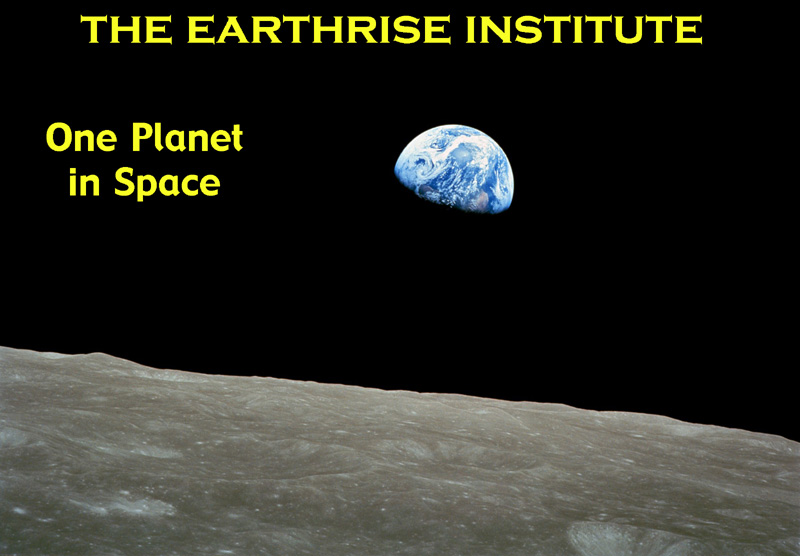
WEEK 9: FEBRUARY 23-29
TOPIC: GREAT COMETS
Few, if any, sights in the nighttime sky are more impressive than that of a bright, long-tailed comet. It is little wonder that our ancestors of just a few centuries ago, who had little idea of what they were actually seeing, were amazed and perhaps even terrified of the sight, and even today the appearance of a bright comet gathers wide notice amongst the general public.
The traditional practice of naming comets after their discoverers did not start until the mid-18th Century. Prior to that, comets were primarily known as the “Comet of <the year of their appearance>” or, perhaps more commonly, the “Great Comet of <the year of their appearance>.” Even after the naming convention started, bright comets would sometimes spring into view seemingly out of nowhere, and the moniker “Great Comet of <year>” still appears in the list of observed comets. Nowadays almost all comets are formally named for their discoverers – although, more often than not, today the discovering entity may be a survey program rather than a specific person or persons – but, even so, a comet bright enough to rate the title may still be referred to informally as the “Great Comet of <year>.”
There is no formal definition as to what constitutes a “Great Comet,” and even any informal definition must to some extent be subjective. Still, a good working definition might be any comet that becomes bright and/or impressive enough such that casual sky-watchers who were previously unaware of its existence would notice it. Indeed, prior to the invention of the telescope in the early 17th Century, just about any comet that people observed would have had to meet this criterion, and thus all comets that were seen before that time would of necessity be “Great Comets.”
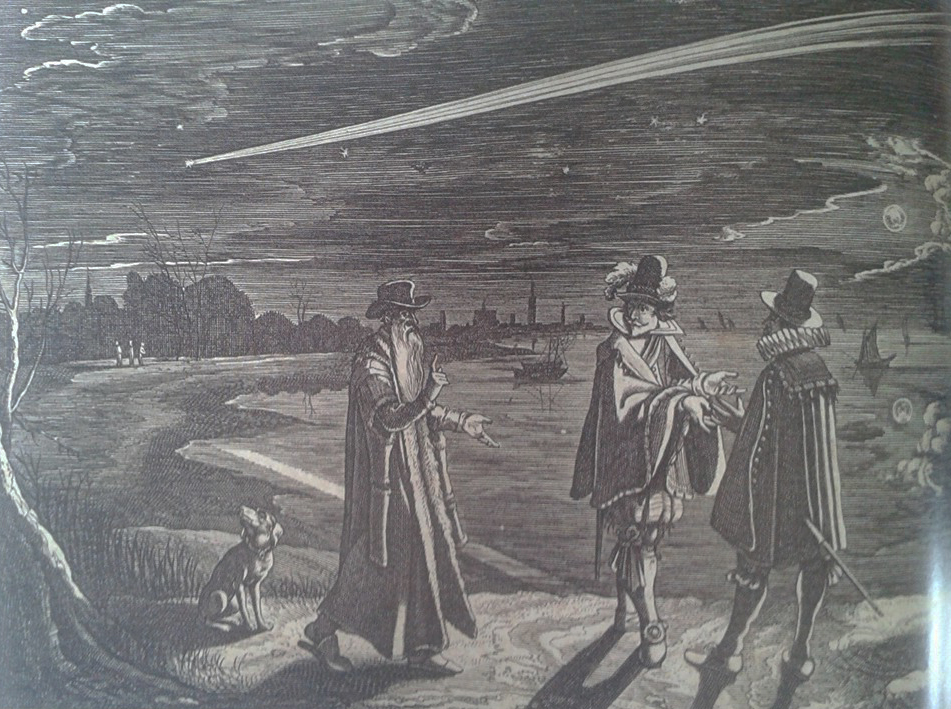
 Historical “Great Comets.” Left: The “Great Comet” that appeared in November 1618 (one of three bright comets that appeared that year), as painted by Dutch painter Adriaen Pietersz van de Venne. Right: The tails of Comet de Chesaux rising above the horizon on the morning of March 7, 1744. It is possible that these are the tips of “synchronic bands” of a more extensive dust tail.
Historical “Great Comets.” Left: The “Great Comet” that appeared in November 1618 (one of three bright comets that appeared that year), as painted by Dutch painter Adriaen Pietersz van de Venne. Right: The tails of Comet de Chesaux rising above the horizon on the morning of March 7, 1744. It is possible that these are the tips of “synchronic bands” of a more extensive dust tail.
Given this working definition, it is appropriate to consider just what factors go into making a comet a “Great” one. As is true for just about anything in life, there is no “one size fits all” set of factors, and some “Great” comets may exhibit one or more factors while other comets may exhibit others – and not all comets that exhibit the factors end up being “Great” ones. The overall deciding factor, again, is the appearance it puts on in the nighttime – and sometimes even the daytime – sky.
Certainly one such factor is a comet’s intrinsic, or “true” brightness; all other factors being equal, a large comet would be expected to become brighter than a smaller one. The term usually used with comets is “absolute magnitude,” which is defined as the apparent magnitude it would have if it were viewed from a distance of 1 AU from both the sun and the earth. On the surface this is a straightforward mathematical calculation, at least when it comes to geocentric distances, which is simply an application of the inverse-square brightness law. With distance from the sun, however, not all comets behave the same when there are located at varying distances, and usually some assumptions – which may or may not necessarily be valid in all cases– need to be utilized. What is usually done in practice is that an inverse-nth (where “n” is generally some number higher than 2) brightness behavior is applied. For most cases “n” is usually assumed to be 3 or 4, as this tends to encompass the behavior of the majority – although certainly not all – comets that have been studied.
The brightest comet, intrinsically, ever recorded was Comet Sarabat in 1729 which -- again, depending upon the assumed value of “n” -- had an absolute magnitude as bright as -3. However, that comet had a perihelion distance of slightly over 4 AU -- as opposed to 0.9 AU for Hale-Bopp -- and thus was never brighter than 3rd or 4th magnitude.
Clearly, then, another factor is a comet's perihelion distance. The closer a comet comes to the sun, the
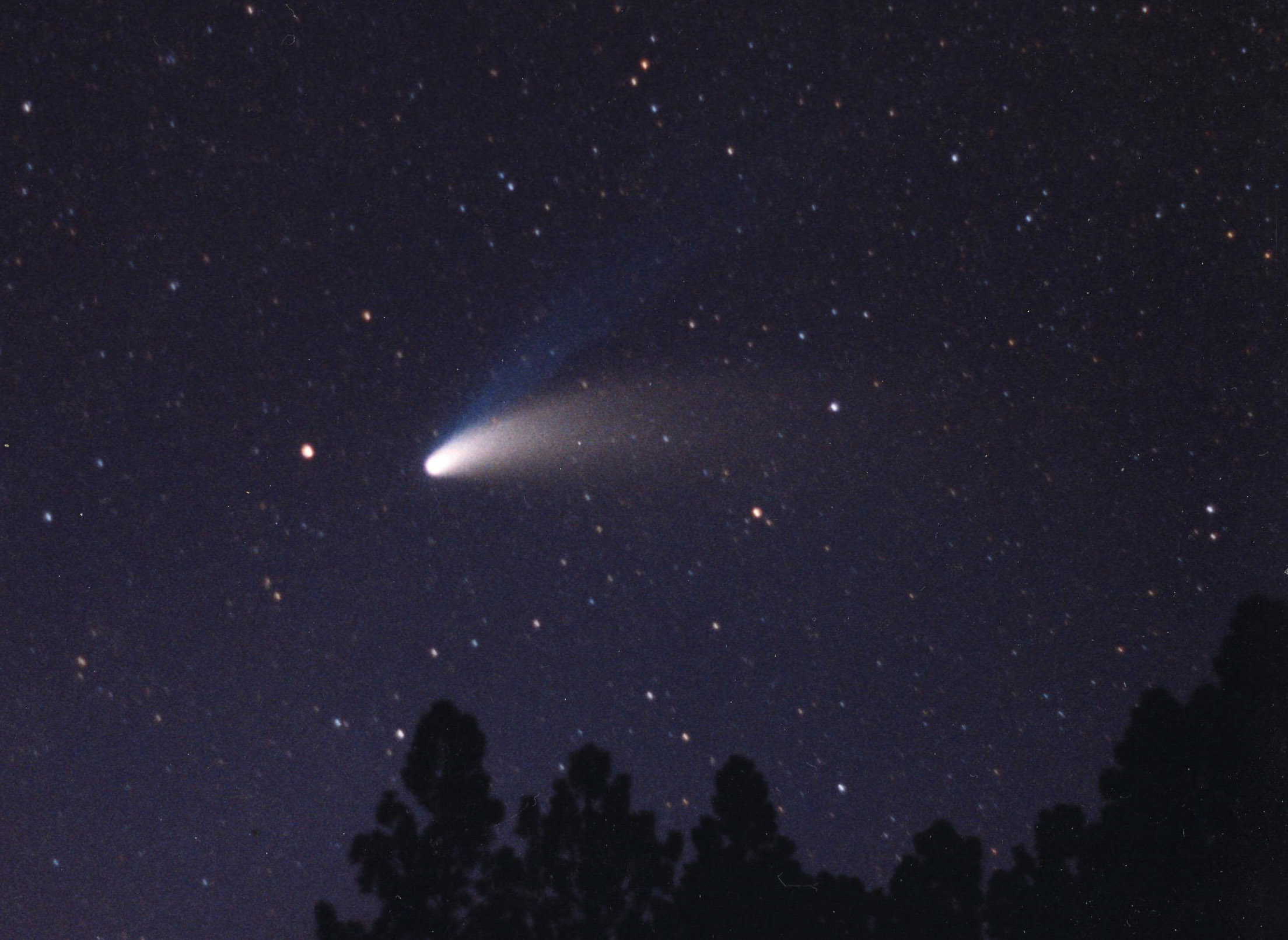
more activity it -- normally -- exhibits, and thus the brighter it would be expected to become, all other things being equal. (The increased level of activity is the primary reason that “n” is usually assumed to be greater than 2 in calculations of a comet’s absolute magnitude.) The Kreutz sungrazers, with perihelion distances less than 0.01 AU, take this to an extreme, and in fact members of this group with just modest absolute magnitudes have become quite bright and “Great” – for example, Comet Lovejoy C/2011 W3.
Smaller perihelion distances can also affect the potential “Great”-ness of comets in other ways. The increased solar heating at smaller heliocentric distances puts greater stress on a comet’s nucleus, which in some cases can lead to splitting of that nucleus. This in turn exposes previously-hidden regions of cometary ice to sudden sunlight, and often leads to an upsurge in brightness. Comet West 1975n split into four separate fragments as it passed through perihelion in early 1976, and this made a significant contribution to the brilliant display that the comet put on afterwards.
On the other hand, especially if a comet’s nucleus is small to begin with, the solar heating at small heliocentric distances can cause that nucleus to disintegrate. Comet ISON in 2013, with a perihelion distance of just over 0.01 AU, had the potential to put on a brilliant display after perihelion, but its nucleus evaporated as it rounded the sun and there was nothing left to see afterwards.
A comet’s distance from Earth can also affect its potential “Great”-ness, as even a more “ordinary” comet might become “Great” if it passes close enough to Earth. Comet Hyakutake in 1996 passed just over 0.1 AU from Earth as it was inbound to perihelion, which not only caused it to brighten to magnitude 0 at the time but it also presented Earth with a broadside view of its tail which created an extraordinary apparent length – at least 70 degrees or longer.
The composition of a comet’s nucleus is another factor that can determine how “Great” it might become. For example, a comet with a high fraction of ices and other volatile substances would likely exhibit more activity as it approaches perihelion than the “average” comet, which in turn might cause it to brighten more rapidly than expected. On the other hand, the ion tail created by the sublimated ices is brightest in the blue end of the visual spectrum, and while it may be quite impressive on blue-sensitive film or detectors, human eyes are not especially sensitive to blue wavelengths and thus a comet’s ion tail is normally not too impressive visually. The long tail that Comet Hyakutake exhibited when it passed by Earth in 1996 was an ion tail that was impressive when viewed from dark rural sites but significantly less impressive when viewed from sites with even moderate light pollution.
Dust from a comet, meanwhile, “shines” by reflected sunlight, to which human eyes are much more sensitive. Thus, a comet with a high dust content, and which can produce a significant dust tail, will appear more impressive visually than an otherwise similar comet with only an ion tail. Comet West in 1976, Comet Hale-Bopp in 1997, and Comet McNaught in 2007 all had prominent dust tails, and accordingly all three were spectacular objects.
If a comet with a high dust content is between the sun and Earth or, in other words, if a comet is viewed at a high “phase” angle (the angle Earth-comet-sun), the dust in its coma and tail may exhibit a phenomenon known as “forward scattering of sunlight.” Dust particles of these sizes preferentially scatter sunlight in a forward direction; one common example of this occurs if one is driving towards the sunset with a dusty windshield. With comets, forward scattering can increase a comet’s brightness, sometimes quite dramatically, during those periods when phase angles are high. Comets West and McNaught both exhibited phase angles in excess of 140 degrees for a time and thus their respective brightnesses were significantly enhanced as a result.
The viewing geometry under which we observe a comet can certainly affect the display it puts on in our skies. A comet might become quite bright in terms of its total magnitude but if it can only be viewed at a low altitude in twilight it may not become especially impressive, whereas a dimmer comet that is viewed higher up in a dark sky might become rather spectacular. Comet PANSTARRS C/2011 L4 became as bright as magnitude 1.5 when it passed through perihelion in March 2013, and moreover was a rather dusty comet with a bright dust tail, however it remained on the far side of the sun from Earth – and consequently there was no brightness enhancement due to forward scattering – and was buried in twilight at an elongation of only 15 degrees when it was brightest, and thus never became what most observers might consider a “Great” comet despite its high brightness.
One additional factor that can affect a comet’s potential “Great”-ness is its dynamical history. Comets that have remained in the Oort Cloud since the formation of the solar system may have acquired a thick organic “crust” overlaid by a mix of volatile substances, and when an incoming comet from the Oort Cloud starts to experience solar heating for the first time this outer layer of volatiles may begin sublimating at a rather large heliocentric distance and create the impression of a higher intrinsic brightness than the comet actually possesses. Once this is completed, however, the organic crust causes the comet to decrease its activity significantly, until the increased solar heating at smaller heliocentric distances starts to break apart this crust and expose the volatiles underneath. On the other hand, a comet that has been around at least once before and that no longer possesses this organic crust – or, in other words, has been “broken in” – will generally exhibit a more accurate level of its true intrinsic brightness as it is inbound to subsequent perihelion passages.
If a first-time visitor from the Oort Cloud is discovered during its initial period of activity, this can lead to expectations that it might become significantly brighter than it actually ends up becoming – leading to, among other things, disappointment amongst the viewing public. The best-known example of this is Comet Kohoutek in 1973 which in part because of its small perihelion distance (0.14 AU) led to early predictions that it would become the “Comet of the Century.” Although it did become moderately bright as viewed from dark rural sites, Comet Kohoutek was significantly less impressive than these predictions, and is widely considered as a “fizzle.” (To be sure, other potential “Great Comets” that were first-time visitors from the Oort Cloud have performed even more poorly.) It is usually possible to tell after two or three months of positional data whether or not a newly-discovered long-period comet is a first-time visitor from the Oort Cloud, and if it is found to be such then expectations can be downsized accordingly.
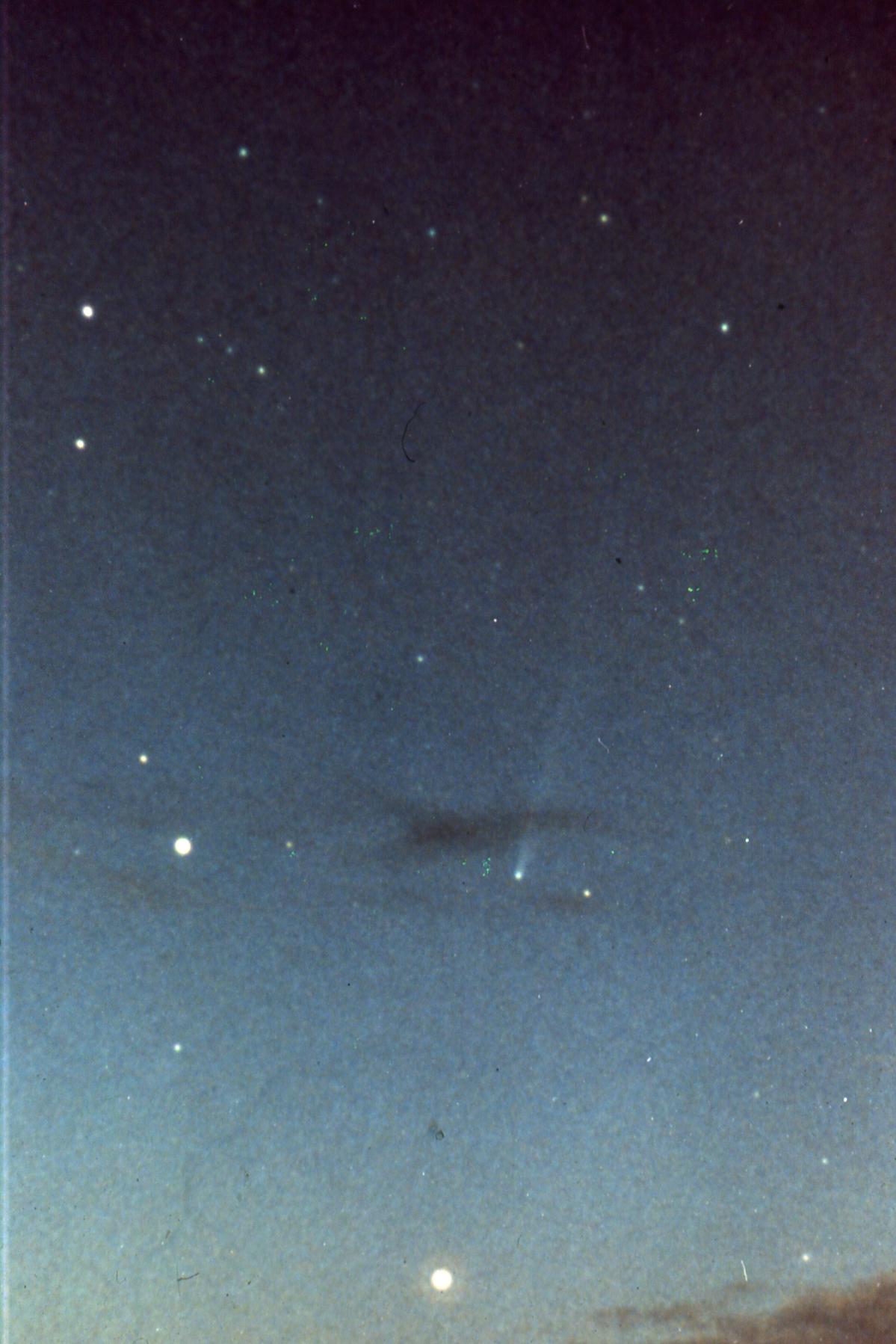
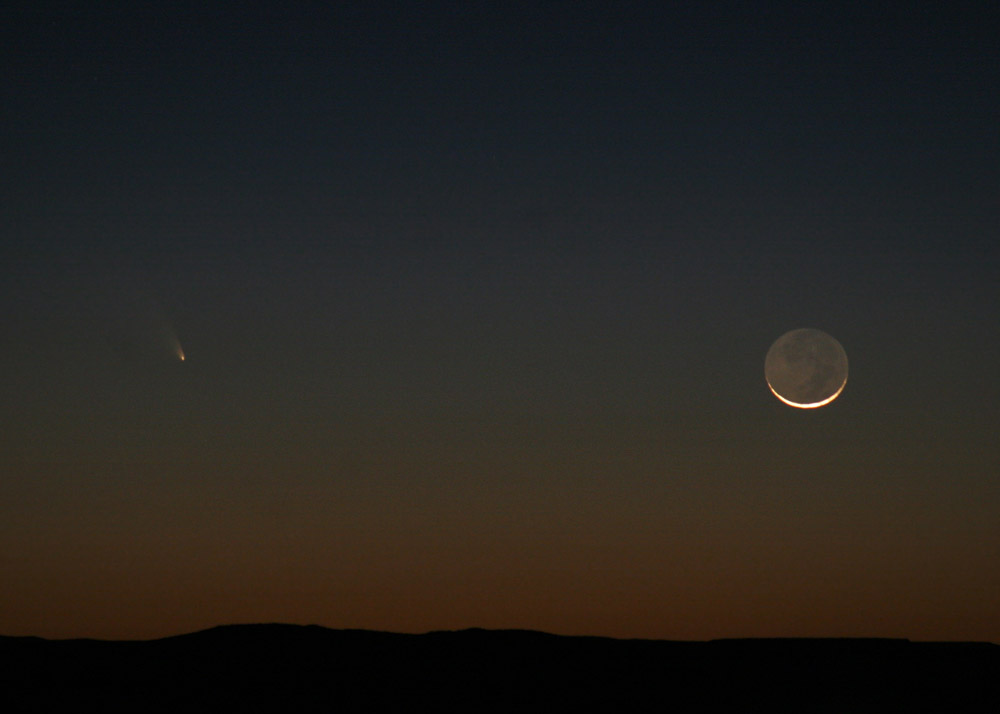 Two comets that didn't quite make “Great Comet” status. Left: Comet Kohoutek 1973f on the evening of January 7, 1974. Photograph courtesy Dennis di Cicco. Right: Comet PANSTARRS C/2011 L4 and the one-day-old crescent moon on the evening of March 12, 2013, from Cerrillos, New Mexico. This photo is an approximate cross between its naked-eye appearance and its appearance in binoculars. Courtesy Peter Lipscomb.
Two comets that didn't quite make “Great Comet” status. Left: Comet Kohoutek 1973f on the evening of January 7, 1974. Photograph courtesy Dennis di Cicco. Right: Comet PANSTARRS C/2011 L4 and the one-day-old crescent moon on the evening of March 12, 2013, from Cerrillos, New Mexico. This photo is an approximate cross between its naked-eye appearance and its appearance in binoculars. Courtesy Peter Lipscomb.
All of the above factors go into determining whether or not a comet becomes a “Great” one. While just about all of these can, to some extent at least, be determined ahead of time, still, it is the comet’s actual performance that ultimately determines if it is indeed a “Great” comet. Despite everything we have learned about them, they can still be notoriously unpredictable, and essentially all we can do is see what a comet actually does. To quote David Levy, “Comets are like cats; they have tails and do exactly what they want.” Or, to quote comet scientist Fred Whipple, “If you must bet, bet on a horse, not on a comet!”
Since I first started observing comets in early 1970 I have seen four comets that I, and most other comet observers, would consider to be “Great” comets. These are:
Comet Bennett in 1970: moderately high intrinsic brightness, high dust content, not a first-time Oort Cloud visitor.
Comet West in 1976: high dust content, small perihelion distance, fragmenting of nucleus, high phase angle, not a first-time Oort Cloud visitor.
Comet Hyakutake in 1996: close approach to Earth, good viewing geometry, not a first-time Oort Cloud visitor.
Comet Hale-Bopp in 1997: high intrinsic brightness, high dust content, not a first-time Oort Cloud visitor.
In addition, since Comet Hale-Bopp there have been two more “Great Comets” that were pretty much exclusively visible from the southern hemisphere (although Comet McNaught was visible in daytime from both hemispheres around perihelion passage).
Comet McNaught in 2007: high dust content, small perihelion distance, high phase angle.
Comet Lovejoy in 2011: very small perihelion distance (Kreutz sungrazer), high dust content, not a first-time Oort Cloud visitor.
All six of these comets, and indeed all of the other comets discussed above with the exceptions of Comet Sarabat and Comet PANSTARRS C/2011 L4, either have been or will be “Comets of the Week” sometime during the course of “Ice and Stone 2020.”
An appropriate question would be: when will the next “Great Comet” appear? A look back over the history of comets’ appearances suggests that the average rate of “Great Comets” is about one per decade, although as in any random collection there can be wide variations in this. Nevertheless, the northern hemisphere, at least, is well overdue for one.
Meanwhile, Comet PANSTARRS C/2017 K2 possesses a high intrinsic brightness -- indeed, it was located at a heliocentric distance of 16 AU when it was discovered almost three years ago. Unfortunately, it falls short when some of the other factors are considered: its perihelion distance is relatively large (1.8 AU), it never comes close to Earth (being located on the far side of the sun from Earth when at perihelion), and it appears to be a first-time visitor
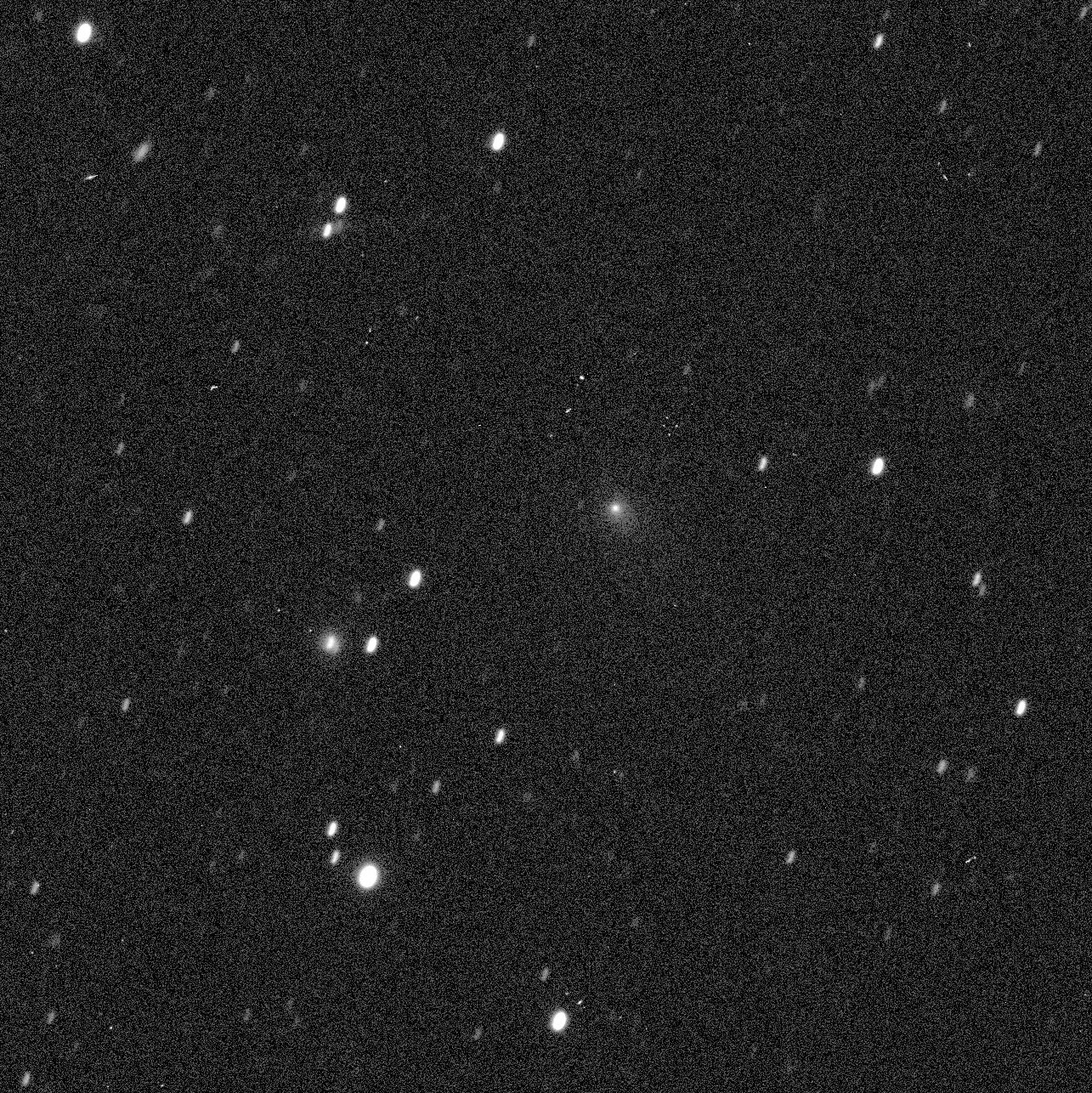
In any event, I would like to see at least one more “Great Comet” before all is said and done. We’ll see what happens with Comet ATLAS C/2019 Y4, and meanwhile “Ice and Stone 2020” will certainly cover other potential “Great Comets” if any should happen to come our way this year.
“Special Topics” archive
Ice and Stone 2020 home page
Earthrise Institute home page